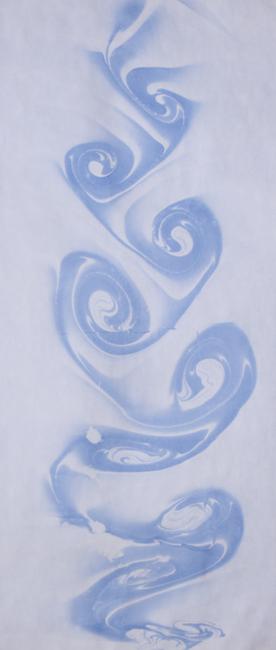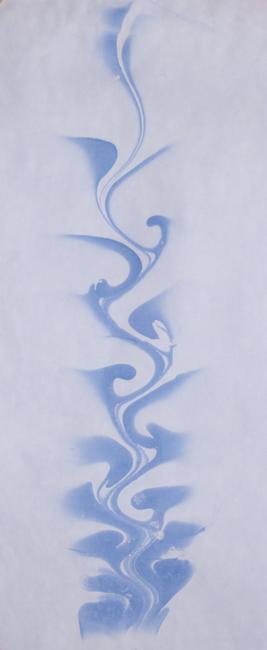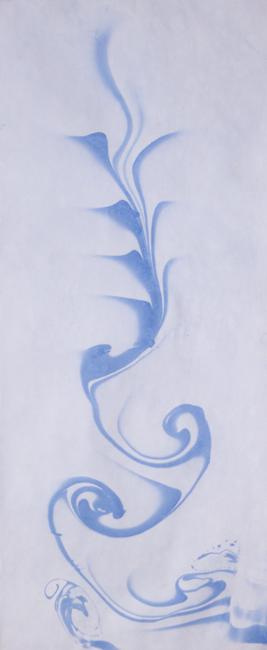
Kármán vortex street, generated by a paddle and captured on paper with dye. The inrolling motion, clockwise at left, counter-clockwise at right, has developed more fully, and the alternating vortexes are clearly discernible. Paddle movement is downwards. From a workshop with Nigel Wells. Archives of Institute of Ecological Technology.
Flip, flap, flip, flap, the tail fin of the trout swishes to and fro, thrusting the fish forward in the still water. Silently it speeds away under the surface. Seemingly without effort it moves, leaving a series of wakes behind. As a contrast, our propeller thrusts water backwards indiscriminately, creating a white foam of turbulent water behind the boat. How can the fish swim so fast and elegant, almost effortlessly?
The secret is to impart a wave motion, the surface of the body, particularly the tail fin, swings to and fro at a particular rhythm that the fish has learned by heart, reducing the resistance of the water, and giving it an unprecedented thrust trough the water. Such an oscillating movement has been shown to have an efficiency reaching 87 per cent.
Swinging to and fro the fish creates a series of vortexes, a Kármán vortex street, each vortex acting for a moment as a wall that it can use as a fulcrum. Such a vortex street can also be observed by gently displacing water in a shallow container. By pouring a small amount of glycerine mixed with dye on the water surface, and then bringing the mass of water in motion, e.g. with a wooden spoon or small paddle, a vortex street can be visualized, and even captured by applying a paper on the water surface. An inward rolling pattern, alternating, always recognizable as the same phenomenon, yet different every time. The inrolling vortex street is the trail we have to follow, in order to understand the motion of the fish.
Whereas the vortexes in the vortex street behind the paddle spirals backwards (away from the paddle) at the outer sides of the street, and thus forwards (towards the paddle) at its centre, a pattern associated with the drag felt when pulling the paddle, the vortex street after the fish is reversed. There, the vortexes spiral forwards at the outer sides of the street and backwards at the centre, providing the thrust the fish needs.
Such a vortex street, when produced by other objects, can also be used by the fish to aid its own propulsion. Research has shown that fish can collect energy from the unsteady motion of streaming water, allowing them to travel against the current with less effort, and to save energy when schooling.

Depending on the vigorousness of the motion, more or less of the circular inrolling motion can be captured.
Could our boats not behave like the fish? Could it not have a soft deformable hull surface and a tail swinging to and fro? At least some very crude attempts of this have been tried. Swinging a single fin requires precision to get a vortex street thrust forming, indicating just how skilled an equilibrist the fish actually is, but by using two fins, waving in opposite directions, a more stable vortex street and a reliable thrust can be produced. Even more, the energy from surface waves of the seas could be practically harvested, just like the trout travelling against the current do in unsteady streams, and can be used to thrust the boat forward, by using undulating fins below the boat. Such a boat has been shown to reach 6-12 knots by just collecting the energy from natural water waves, and can reach even higher speed if extra energy is supplied to oscillate the fins.
The trout, swimming elegantly under the surface, is waiting for us to follow suit.
Read more
For a general introduction to Kármán vortex streets, see:
- Wikipedia, Kármán vortex street
The following article gives a good overview of fish locomotion and schooling, and how this is related to vortex street formation:
- Sfakiotakis, Michael, Lane, D.M., Davies, J.B.C. Review of fish swimming modes for aquatic locomotion IEEE Journal of Oceanic Engineering, Vol. 24 , Issue. 2 , Apr 1999, pp. 237 – 252.
Sea animals have been using these ideas for ages. Here are some papers demonstrating the ability of fish and whales to extract vortex and wave energy for their own propulsion:
- N. Bose & J. Lien Energy Absorption from Ocean Waves: A Free Ride for Cetaceans Proc. R. Soc. Lond. B, Vol. 240, Iss. 1299, 22 June 1990, pp. 591-605
- James C. Liao, David N. Beal, George V. Lauder & Michael S. Triantafyllou The Kármán gait: novel body kinematics of rainbow trout swimming in a vortex street The Journal of Experimental Biology, Vol. 206, 15 Mar 2003, pp. 1059-73
- James C. Liao, David N. Beal, George V. Lauder & Michael S. Triantafyllou Fish Exploiting Vortices Decrease Muscle Activity Science, Vol. 302, Iss. 5650, 28 November 2003, pp. 1566-1569
Papers describing the research in Norway and Japan on wave propulsion in the 1970’s and 1980’s:
- Einar Jakobsen The foilpropeller, wave power for propulsion Proceedings of the Second International Symposium on Wave & Tidal Energy, BHRA Fluid Engineering, 1981, pp. 363–369
-
Dybdahl K. Foilpropellen kan revolusjonere skipsfarten Teknisk Ukeblad, no. 39, October 1988, pp. 10-11
- H. Isshiki Wave Energy Utilization Into Ship Propulsion By Fins Attached to a Ship The Fourth International Offshore and Polar Engineering Conference, 10-15 April 1994, Osaka, Japan. International Society of Offshore and Polar Engineers.
An interesting overview of the history of wave propulsion:
- www.wavepropulsion.com (by Eirik Bøckmann, Department of Marine Technology, Norwegian University of Science and Technology, Trondheim, Norway)
This study on energy extraction from oscillationg foils by Andeson & al. showed up to 87% efficiency, well above the efficiency of the ordinary propeller:
- J. M. Anderson, K. Streitlien, D. S. Barrett & M. S. Triantafyllou Oscillating foils of high propulsive efficiency Journal of Fluid Mechanics, Vol. 360, April 1998, pp. 41-72
Christian Borgen has written an interesting study of wave propulsion technology and reports a fuel reduction of up to 60% from boat simulations:
- Christian Thomas Borgen Application of an Active Foil Propeller M.Sc. Thesis, Department of Marine, Norwegian University of Science and Technology, Trondheim, Norway, 2010


